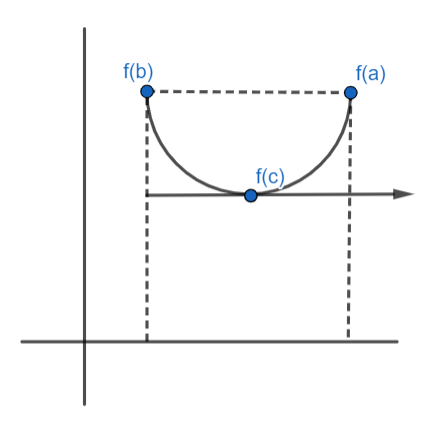
State Rolle’s theorem.
Answer
603k+ views
Hint: Rolle’s theorem is a special case of Mean value theorem. So, we will discuss Mean value theorem, then we will state Rolle's theorem with the help of a suitable proof.
Complete step-by-step answer:
It is given in the question to state Rolle’s theorem. So, basically Rolle’s theorem is a special case of Mean value theorem. It can also be called a mean value theorem (MVT). So, (MVT) stated that ‘if $f(x)$ is a function in an interval of $(a,b)$ and $f(x)$ can be differentiable on $(a,b)$ then we have at least one value $c$ in the interval $(a,b)$. Where, $a < c < b$.
${{f}^{1}}(c)=\dfrac{f(b)-f(a)}{b-a}$.
Whereas, Rolle’s theorem is a special case of MVT. Where,
$f(a)=f(b)$. So, here we have ${{f}^{1}}(c)=0$.
${{f}^{1}}(c)$ Rolle’s theorem states that if a function $f$ is continuous on the closed interval $[a,b]$ and differentiable on the open interval $(a,b)$ such that $f(a)=f(b)$. Then ${{f}^{1}}(c)=0$ for some values of $c$ with $a\le c\le b$.

Here in this diagram we have function $f(b)=f(a)$ and ${{f}^{1}}(c)$ is parallel to x-axis which means ${{f}^{1}}(c)=0$. So, $f$ is continuous on $[a,b]$. Therefore, it assumes absolute maximum and minimum values on $[a,b]$.
Note: Rolle’s theorem is important because it gives a necessary condition for critical points; it is used in the proof of the Intermediate value theorem. In fact, IVT is similar to Rolle’s theorem. Rolle’s theorem states that ‘If a function $f(x)$ is defined in the closed interval $[a,b]$ in such a way that it satisfies the following conditions –
1. The function $f(x)$ is continuous in $[a,b]$.
2. $f(x)$ is differentiable in $(a,b)$.
3. $f(a)=f(b)$.
Then there exists at least one value of $x$ such that ${{f}^{1}}(c)=0$’.
Complete step-by-step answer:
It is given in the question to state Rolle’s theorem. So, basically Rolle’s theorem is a special case of Mean value theorem. It can also be called a mean value theorem (MVT). So, (MVT) stated that ‘if $f(x)$ is a function in an interval of $(a,b)$ and $f(x)$ can be differentiable on $(a,b)$ then we have at least one value $c$ in the interval $(a,b)$. Where, $a < c < b$.
${{f}^{1}}(c)=\dfrac{f(b)-f(a)}{b-a}$.
Whereas, Rolle’s theorem is a special case of MVT. Where,
$f(a)=f(b)$. So, here we have ${{f}^{1}}(c)=0$.
${{f}^{1}}(c)$ Rolle’s theorem states that if a function $f$ is continuous on the closed interval $[a,b]$ and differentiable on the open interval $(a,b)$ such that $f(a)=f(b)$. Then ${{f}^{1}}(c)=0$ for some values of $c$ with $a\le c\le b$.

Here in this diagram we have function $f(b)=f(a)$ and ${{f}^{1}}(c)$ is parallel to x-axis which means ${{f}^{1}}(c)=0$. So, $f$ is continuous on $[a,b]$. Therefore, it assumes absolute maximum and minimum values on $[a,b]$.
Note: Rolle’s theorem is important because it gives a necessary condition for critical points; it is used in the proof of the Intermediate value theorem. In fact, IVT is similar to Rolle’s theorem. Rolle’s theorem states that ‘If a function $f(x)$ is defined in the closed interval $[a,b]$ in such a way that it satisfies the following conditions –
1. The function $f(x)$ is continuous in $[a,b]$.
2. $f(x)$ is differentiable in $(a,b)$.
3. $f(a)=f(b)$.
Then there exists at least one value of $x$ such that ${{f}^{1}}(c)=0$’.
Recently Updated Pages
Why are manures considered better than fertilizers class 11 biology CBSE

Find the coordinates of the midpoint of the line segment class 11 maths CBSE

Distinguish between static friction limiting friction class 11 physics CBSE

The Chairman of the constituent Assembly was A Jawaharlal class 11 social science CBSE

The first National Commission on Labour NCL submitted class 11 social science CBSE

Number of all subshell of n + l 7 is A 4 B 5 C 6 D class 11 chemistry CBSE

Trending doubts
What is meant by exothermic and endothermic reactions class 11 chemistry CBSE

10 examples of friction in our daily life

One Metric ton is equal to kg A 10000 B 1000 C 100 class 11 physics CBSE

1 Quintal is equal to a 110 kg b 10 kg c 100kg d 1000 class 11 physics CBSE

Difference Between Prokaryotic Cells and Eukaryotic Cells

What are Quantum numbers Explain the quantum number class 11 chemistry CBSE




